Evaluation of Terrestrial Water Storage Changes over China Based on GRACE Solutions and Water Balance Method
Abstract
:1. Introduction
2. Materials and Methods
2.1. Study Area
2.2. Datasets
2.2.1. GRACE Solutions
2.2.2. GLDAS Simulations
2.2.3. Meteorological Data
2.3. Methods for Estimating TWSA
2.3.1. Estimation of TWSA Based on the Water Balance Algorithm
2.3.2. Mann–Kendall Trend Test Algorithm
2.3.3. Evaluation Index
2.3.4. Research Framework
3. Results
3.1. Evaluation of Different Meteorological Products
3.2. Comparison of TWSA Based on GRACE Solutions
3.3. Evaluation of TWSA Estimates over 10 RBs
4. Discussion
4.1. Comparisons of TWSA Calculated by GRACE and WB Method
4.2. Limitations and Insights of This Research
5. Conclusions
Author Contributions
Funding
Institutional Review Board Statement
Informed Consent Statement
Data Availability Statement
Acknowledgments
Conflicts of Interest
Abbreviations
| Full Names | Abbreviations |
|---|---|
| Gravity Recovery and Climate Experiment | GRACE |
| GRACE Follow-on | GRAE-FO |
| Global Land Data Assimilation System | GLDAS |
| Center for Space Research | CSR |
| Jet Propulsion Laboratory | JPL |
| GeoForschungsZentrum Potsdam | GFZ |
| Goddard Space Flight Center | GSFC |
| Mass Concentration Blocks | Mascons |
| Terrestrial Water Storage | TWS |
| Terrestrial Water Storage Anomalies | TWSA |
| Terrestrial Water Storage Changes | TWSC |
| Snow Water Equivalent | SWE |
| Soil Moisture | SMS |
| Plant Canopy Surface Water | PCSW |
| Correlation Coefficient | CC |
| Nash-Sutcliffe Efficiency Coefficient | NSE |
| Root Mean Square Error | RMSE |
| Mean Absolute Error | MAE |
| River Basin | RB |
| Water Balance | WB |
| Land Surface Models | LSMs |
| Global Hydrological and Water Resource Models | GHWRMs |
| Evapotranspiration | ET |
| Precipitation | Precp |
| China Meteorological Administration | CMA |
| Global Precipitation Measurement | GPM |
| Tropical Rainfall Measuring Mission | TRMM |
| Global Land Evaporation Amsterdam Model | GLEAM |
| The European Centre for Medium-Range Weather Forecasts Reanalysis 5 | ERA5 |
References
- Famiglietti, J.S.; Rodell, M. Water in the Balance. Science 2013, 340, 1300–1301. [Google Scholar] [CrossRef] [PubMed]
- Long, D.; Yang, W.; Scanlon, B.R.; Zhao, J.; Liu, D.; Burek, P.; Pan, Y.; You, L.; Wada, Y. South-to-North Water Diversion stabilizing Beijing’s groundwater levels. Nat. Commun. 2020, 11, 3665. [Google Scholar] [CrossRef] [PubMed]
- Feng, W.; Shum, C.K.; Zhong, M.; Pan, Y. Groundwater Storage Changes in China from Satellite Gravity: An Overview. Remote Sens. 2018, 10, 674. [Google Scholar] [CrossRef]
- Tangdamrongsub, N.; Han, S.-C.; Tian, S.; Müller Schmied, H.; Sutanudjaja, E.H.; Ran, J.; Feng, W. Evaluation of groundwater storage variations estimated from GRACE assimilation and State-of-the-Art Land Surface Models in Australia and the North China Plain. Remote Sens. 2018, 10, 483. [Google Scholar] [CrossRef]
- Scanlon, B.R.; Zhang, Z.; Save, H.; Sun, A.Y.; Müller Schmied, H.; van Beek, L.P.H.; Wiese, D.N.; Wada, Y.; Long, D.; Reedy, R.C.; et al. Global models underestimate large decadal declining and rising water storage trends relative to GRACE satellite data. Proc. Natl. Acad. Sci. USA 2018, 115, 201704665. [Google Scholar] [CrossRef]
- Sutanudjaja, E.; Beek, R.; Wanders, N.; Wada, Y.; Bosmans, J.; Drost, N.; Ent, R.; de Graaf, I.; Hoch, J.; de Jong, K.; et al. PCR-GLOBWB 2: A 5 arcmin global hydrological and water resources model. Geosci. Model Dev. 2018, 11, 2429–2453. [Google Scholar] [CrossRef]
- Müller Schmied, H.; Cáceres, D.; Eisner, S.; Flörke, M.; Herbert, C.; Niemann, C.; Peiris, T.A.; Popat, E.; Portmann, F.T.; Reinecke, R.; et al. The global water resources and use model WaterGAP v2.2d: Model description and evaluation. Geosci. Model Dev. 2021, 14, 1037–1079. [Google Scholar] [CrossRef]
- Yang, X.; Tian, S.; Feng, W.; Ran, J.; You, W.; Zhongshan, J.; Gong, X. Spatio-Temporal Evaluation of Water Storage Trends from Hydrological Models over Australia Using GRACE Mascon Solutions. Remote Sens. 2020, 12, 3578. [Google Scholar] [CrossRef]
- Peng, B.; Liu, X.; Yang, T.; Liang, K.; Liu, C. Evaluation of streamflow simulation results of land surface models in GLDAS on the Tibetan Plateau: GLDAS runoff simulations on the TP. J. Geophys. Res.-Atmos. 2016, 121, 180–197. [Google Scholar]
- Chen, Z.; Zeng, Y.; Shen, G.; Xiao, C.; Xu, L.; Chen, N. Spatiotemporal characteristics and estimates of extreme precipitation in the Yangtze River Basin using GLDAS data. Int. J. Climatol. 2020, 41, E1812–E1830. [Google Scholar] [CrossRef]
- Yin, W.; Yang, S.; Hu, L.; Tian, S.; Wang, X.; Zhao, R.; Li, P. Improving understanding of spatiotemporal water storage changes over China based on multiple datasets. J. Hydrol. 2022, 612, 128098. [Google Scholar] [CrossRef]
- Sun, K.; Hu, L.; Liu, X.; Yin, W. Reconstructing Terrestrial Water Storage Anomalies Using Satellite Data to Evaluate Water Resource Shortages from 1980 to 2016 in the Inland Yongding River Basin, China. Geofluids 2021, 2021, 7275242. [Google Scholar] [CrossRef]
- Yin, W.; Hu, L.; Han, S.C.; Zhang, M.; Teng, Y. Reconstructing terrestrial water Storage Variations from 1980 to 2015 in the Beishan area of China. Geofluids 2019, 2019, 3874742. [Google Scholar] [CrossRef]
- Nie, N.; Zhang, W.; Zhang, Z.; Guo, H.; Ishwaran, N. Reconstructed Terrestrial Water Storage Change (ΔTWS) from 1948 to 2012 over the Amazon Basin with the Latest GRACE and GLDAS Products. Water Resour. Manag. 2016, 30, 279–294. [Google Scholar] [CrossRef]
- Wang, J.; Zhang, J.; Ning, S.; Wang, H. Downscaling analysis of GRACE terrestrial water storage changes in Yunnan province. Water Resour. Power. 2018, 336, 1–5. [Google Scholar]
- Yin, W.; Hu, L.; Zhang, M.; Wang, J.; Han, S.C. Statistical downscaling of GRACE-derived groundwater storage using ET data in the North China Plain. J. Geophys. Res.-Atmos. 2018, 123, 5973–5987. [Google Scholar] [CrossRef]
- Pan, Y.; Zhang, C.; Gong, H.; Yeh, P.; Shen, Y.; Guo, Y.; Zhiyong, H.; Li, X. Detection of Human-induced Evapotranspiration using GRACE Satellite Observations in the Haihe River Basin of China: Detecting Human-induced ET using GRACE. Geophys. Res. Lett. 2016, 44, 190–199. [Google Scholar] [CrossRef]
- Liu, W.; Wang, L.; Zhou, J.; Li, Y.; Sun, F.; Fu, G.; Li, X.; Sang, Y. A worldwide evaluation of basin-scale evapotranspiration estimates against the water balance method. J. Hydrol. 2016, 538, 82–95. [Google Scholar] [CrossRef]
- Rodell, M.; Famiglietti, J.S. An analysis of terrestrial water storage variations in Illinois with implications for the Gravity Recovery and Climate Experiment (GRACE). Water Resour. Res. 2001, 37, 1327–1339. [Google Scholar] [CrossRef]
- Rodell, M.; Velicogna, I.; Famiglietti, J.S. Satellite-based estimates of groundwater depletion in India. Nature 2009, 460, 999–1002. [Google Scholar] [CrossRef]
- Yeh, J.F.; Swenson, S.C.; Famiglietti, J.S.; Rodell, M. Remote sensing of groundwater storage changes in Illinois using the Gravity Recovery and Climate Experiment (GRACE). Water Resour. Res. 2006, 42, W12203. [Google Scholar] [CrossRef]
- Xiong, J.; Yin, J.; Guo, S.; Slater, L. Continuity of terrestrial water storage variability and trends across mainland China monitored by the GRACE and GRACE-Follow on satellites. J. Hydrol. 2021, 599, 126308. [Google Scholar] [CrossRef]
- Long, D.; Longuevergne, L.; Scanlon, B.R. Global analysis of approaches for deriving total water storage changes from GRACE satellites. Water Resour. Res. 2015, 51, 2574–2594. [Google Scholar] [CrossRef]
- Tapley, B.D.; Bettadpur, S.; Ries, J.C.; Thompson, P.F.; Watkins, M.M. GRACE measurements of mass variability in the Earth system. Science 2004, 305, 503–505. [Google Scholar] [CrossRef]
- Feng, W.; Zhong, M.; Lemoine, J.-M.; Biancale, R.; Hsu, H.-T.; Xia, J. Evaluation of groundwater depletion in North China using the Gravity Recovery and Climate Experiment (GRACE) data and ground-based measurements. Water Resour. Res. 2013, 49, 2110–2118. [Google Scholar] [CrossRef]
- Yin, Z.; Dr, Y.; Zhu, X.; Zhao, J.; Yang, Y.; Li, J. Variations of groundwater storage in different basins of China over recent decades. J. Hydrol. 2021, 598, 126282. [Google Scholar] [CrossRef]
- Long, D.; Pan, Y.; Zhou, J.; Chen, Y.; Hou, X.; Hong, Y.; Scanlon, B.R.; Longuevergne, L. Global analysis of spatiotemporal variability in merged total water storage changes using multiple GRACE products and global hydrological models. Remote Sens. Environ. 2017, 192, 198–216. [Google Scholar] [CrossRef]
- Swenson, S.; Wahr, J. Methods for inferring regional surfacemass anomalies from Gravity Recovery and Climate Experiment (GRACE) measurements of time-variable gravity. J. Geophys. Res. 2002, 107, 2193. [Google Scholar]
- Swenson, S.; Wahr, J. Post-processing removal of correlated errors in GRACE data. Geophys. Res. Lett. 2006, 33, L08402. [Google Scholar] [CrossRef]
- Wang, Q.; Zheng, W.; Yin, W.; Kang, G.; Zhang, D. Improving the accuracy of water storage anomaly trends based on a new statistical correction hydrological model weighting method. Remote Sens. 2021, 13, 3583. [Google Scholar] [CrossRef]
- Hu, B.; Wang, L.; Li, X.; Zhou, J.; Pan, Y. Divergent Changes in Terrestrial Water Storage Across Global Arid and Humid Basins. Geophys. Res. Lett. 2021, 48, e2020GL091069. [Google Scholar] [CrossRef]
- Yeh, P.J.F. Terrestrial water storage variation inferred from GRACE satellite and water balance. In Proceedings of the 32nd Asian Conference on Remote Sensing 2011, ACRS, Tapei, Taiwan, 3–7 October 2011; Volume 4, pp. 2850–2855. [Google Scholar]
- Liu, X.; Feng, X.; Ciais, P.; Fu, B.; Hu, B.; Sun, Z. GRACE satellite-based drought index indicating increased impact of drought over major basins in China during 2002–2017. Agric. Forest Meteorol. 2020, 291, 108057. [Google Scholar] [CrossRef]
- Zhai, J.; Liu, B.; Hartmann, H.; Buda, S.; Tong, J.; Fraedrich, K. Dryness/wetness variations in China during the first 50 years of the 21st century. Quatern. Int. 2010, 226, 101–111. [Google Scholar] [CrossRef]
- Wiese, D.; Landerer, F.; Watkins, M. Quantifying and reducing leakage errors in the JPL RL05M GRACE mascon solution. Water Resour. Res. 2016, 52, 7490–7502. [Google Scholar] [CrossRef]
- Zheng, L.; Pan, Y.; Gong, H.; Zhiyong, H.; Zhang, C. Comparing Groundwater Storage Changes in Two Main Grain Producing Areas in China: Implications for Sustainable Agricultural Water Resources Management. Remote Sens. 2020, 12, 21. [Google Scholar] [CrossRef]
- Rodell, M.; Houser, P.R.; Jambor, U.; Gottschalck, J.; Mitchell, K.; Meng, C.J.; Arsenault, K.; Cosgrove, B.; Radakovich, J.; Bosilovich, M.; et al. The Global Land Data Assimilation System. B Am. Meteorol. Soc. 2004, 85, 381–394. [Google Scholar] [CrossRef]
- Zhong, Y.; Zhong, M.; Mao, Y.; Ji, B. Evaluation of evapotranspiration for exorheic catchments of China during the GRACE era: From a water balance perspective. Remote Sens. 2020, 12, 511. [Google Scholar] [CrossRef]
- Rui, H. Readme Document for Global Land Data Assimilation System Version 1 (GLDAS-1). 2014. Available online: https://disc.gsfc.nasa.gov/ (accessed on 1 May 2022).
- Rui, H. Readme Document for Global Land Data Assimilation System Version 2 (GLDAS-2). 2018. Available online: https://disc.gsfc.nasa.gov/ (accessed on 1 May 2022).
- Gong, H.; Pan, Y.; Zheng, L.; Li, X.; Zhu, L.; Zhang, C.; Zhiyong, H.; Li, Z.; Wang, H.; Zhou, C. Long-term groundwater storage changes and land subsidence development in the North China Plain (1971–2015). Hydrogeol. J. 2018, 26, 1417–1427. [Google Scholar] [CrossRef]
- Wang, F.; Wang, Z.; Yang, H.; Di, D.; Zhao, Y.; Liao, Q. A new copula-based standardized precipitation evapotranspiration streamflow index for drought monitoring. J. Hydrol. 2020, 585, 124793. [Google Scholar] [CrossRef]
- Zhang, C.; Shao, H.; Chen, S.; Liu, T.; Chen, C.; Ding, Q.; Du, H. Evaluation and Intercomparison of High-Resolution Satellite Precipitation Estimates—GPM, TRMM, and CMORPH in the Tianshan Mountain Area. Remote Sens. 2018, 10, 1543. [Google Scholar] [CrossRef]
- Martens, B.; Miralles, D.G.; Lievens, H.; van der Schalie, R.; de Jeu, R.A.M.; Férnandez-Prieto, D.; Beck, H.E.; Dorigo, W.A.; Verhoest, N.E.C. GLEAM v3: Satellite-based land evaporation and root-zone soil moisture. Geosci. Model Dev. 2017, 10, 1903–1925. [Google Scholar] [CrossRef]
- Miralles, D.G.; Holmes, T.R.H.; Jeu, R.A.M.D.; Gash, J.H. Global land-surface evaporation estimated from satellite-based observations. Hydrol. Earth Syst. Sci. 2011, 15, 453–469. [Google Scholar] [CrossRef]
- Olauson, J. ERA5: The new champion of wind power modelling? Renew. Energ. 2018, 126, 322–331. [Google Scholar] [CrossRef] [Green Version]
- Sun, W.; Jin, Y.; Jingshan, Y.; Wang, G.; Xue, B.L.; Zhao, Y.; Fu, Y.; Shrestha, S. Integrating satellite observations and human water use data to estimate changes in key components of terrestrial water storage in a semi-arid region of North China. Sci. Total Environ. 2020, 698, 134171. [Google Scholar] [CrossRef] [PubMed]
- Long, D.; Shen, Y.; Sun, A.; Hong, Y.; Longuevergne, L.; Yang, Y.; Li, B.; Chen, L. Drought and Flood Monitoring for a Large Karst Plateau in Southwest China Using Extended GRACE Data. Remote Sens. Environ. 2014, 155, 145–160. [Google Scholar] [CrossRef]
- Mann, H. Non-parametric tests against trend. Econometrica 1945, 13, 245–259. [Google Scholar] [CrossRef]
- Kendall, M. Rank Correlation Methods; Charles Griffin: London, UK, 1975. [Google Scholar]
- Sang, Y.; Wang, Z.; Liu, C. Comparison of the MK Test and EMD Method for Trend Identification in Hydrological Time Series. J. Hydrol. 2014, 510, 293–298. [Google Scholar] [CrossRef]
- Hırca, T.; Türkkan, G.; Niazkar, M. Applications of innovative polygonal trend analyses to precipitation series of Eastern Black Sea Basin, Turkey. Theor. Appl. Climatol. 2022, 147, 651–667. [Google Scholar] [CrossRef]
- Niazkar, M.; Hajizadeh Mishi, F.; Türkkan, G. Assessment of Artificial Intelligence Models for Estimating Lengths of Gradually Varied Flow Profiles. Complexity 2021, 2021, 5547889. [Google Scholar] [CrossRef]
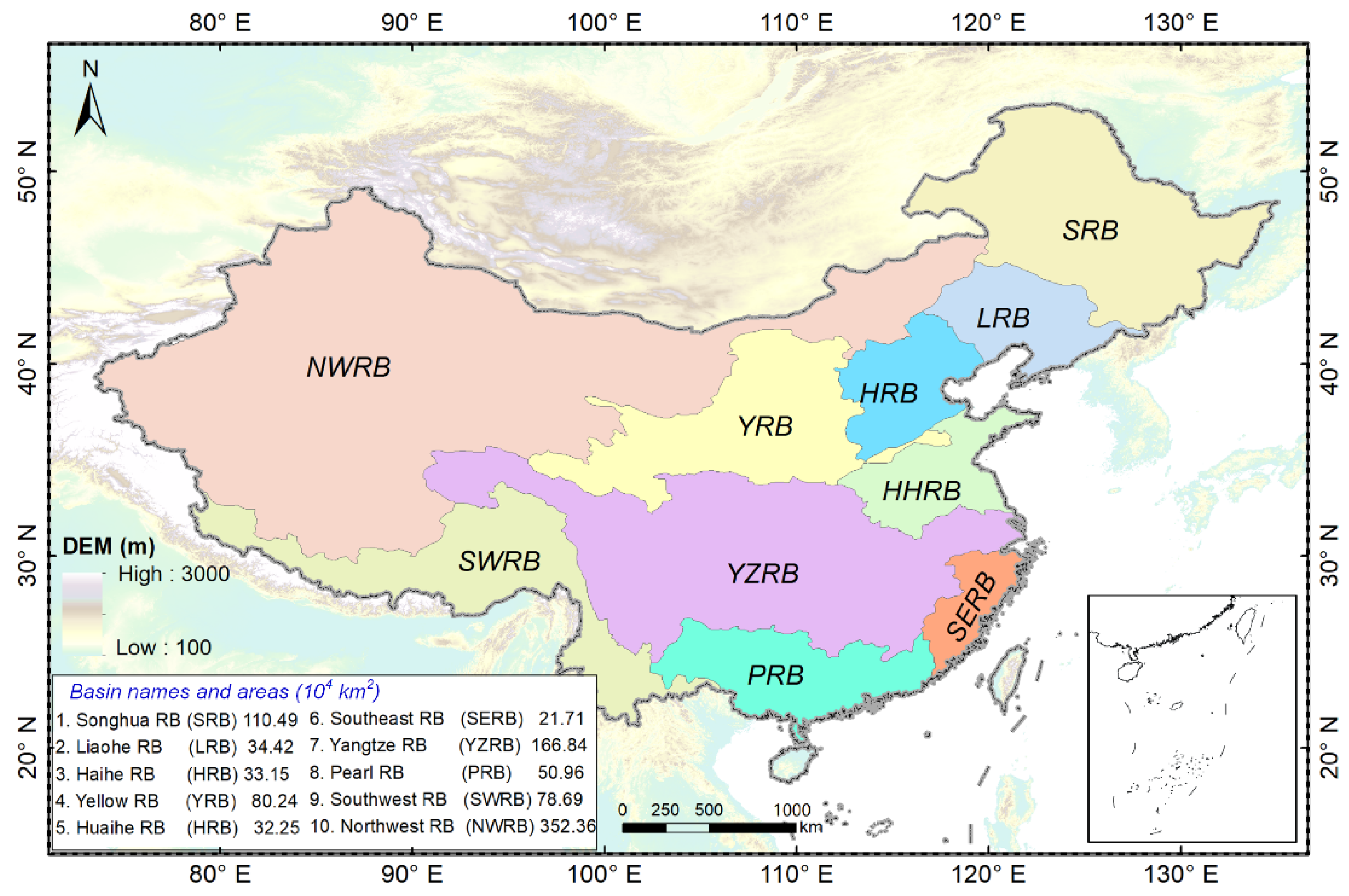
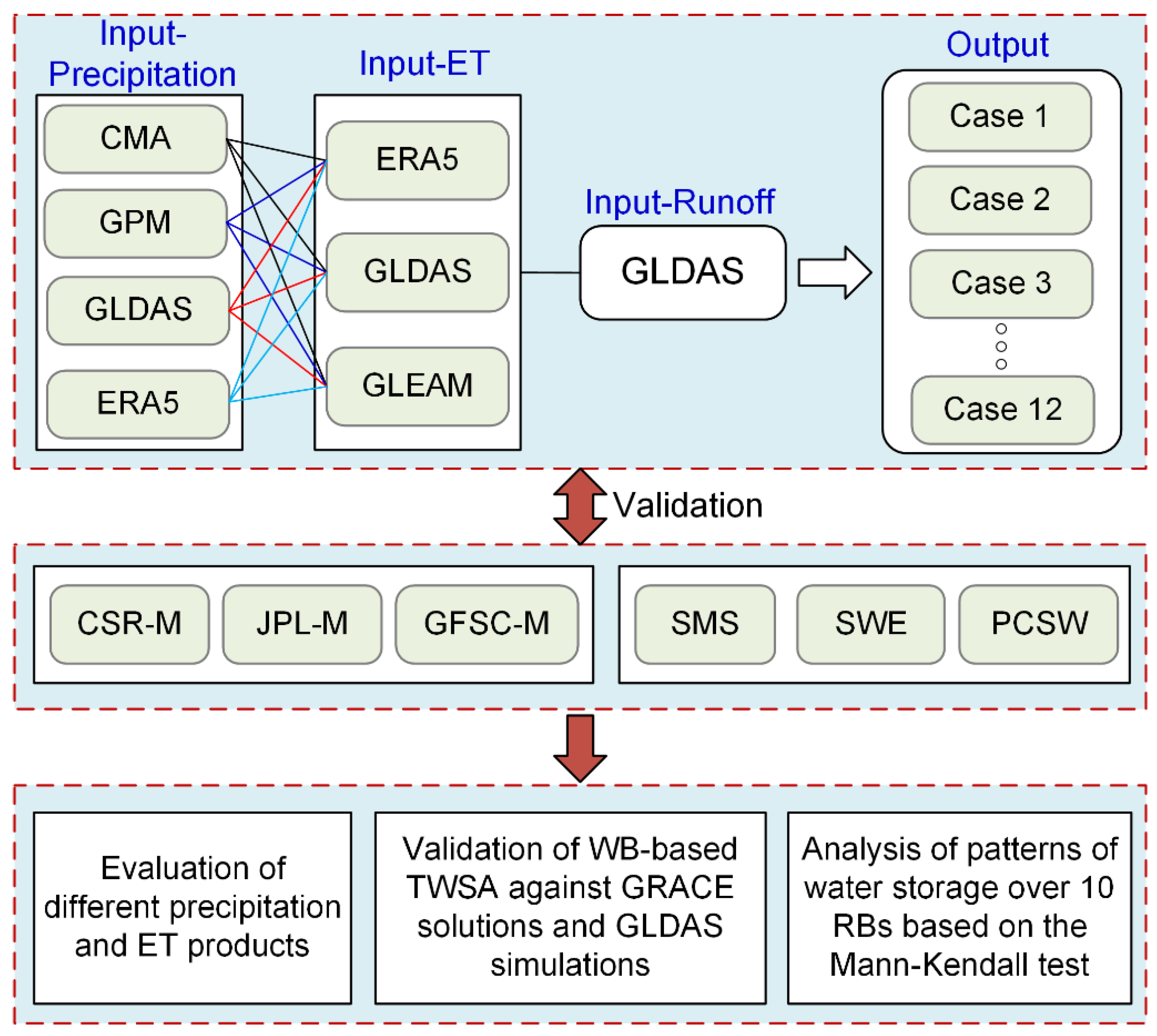
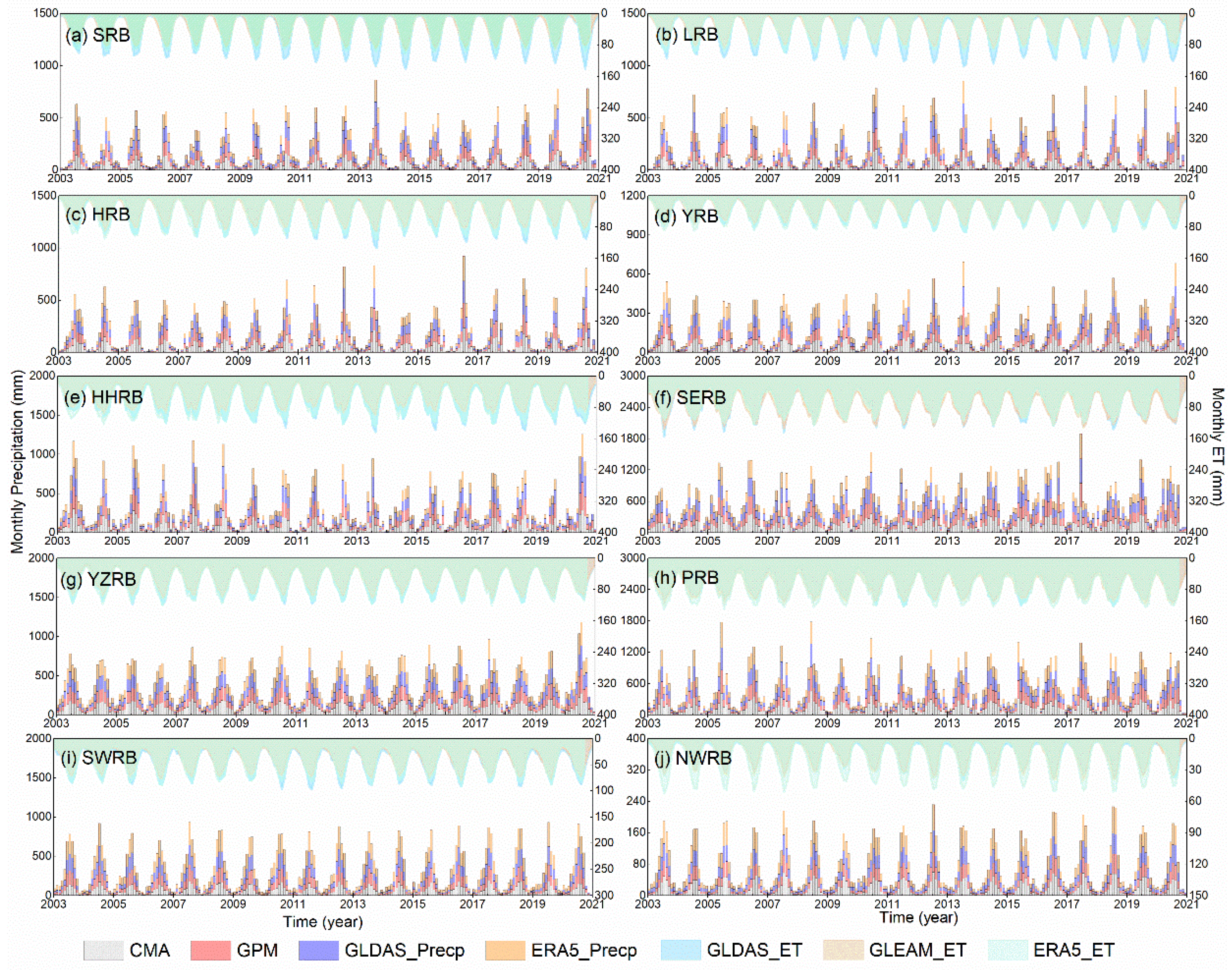

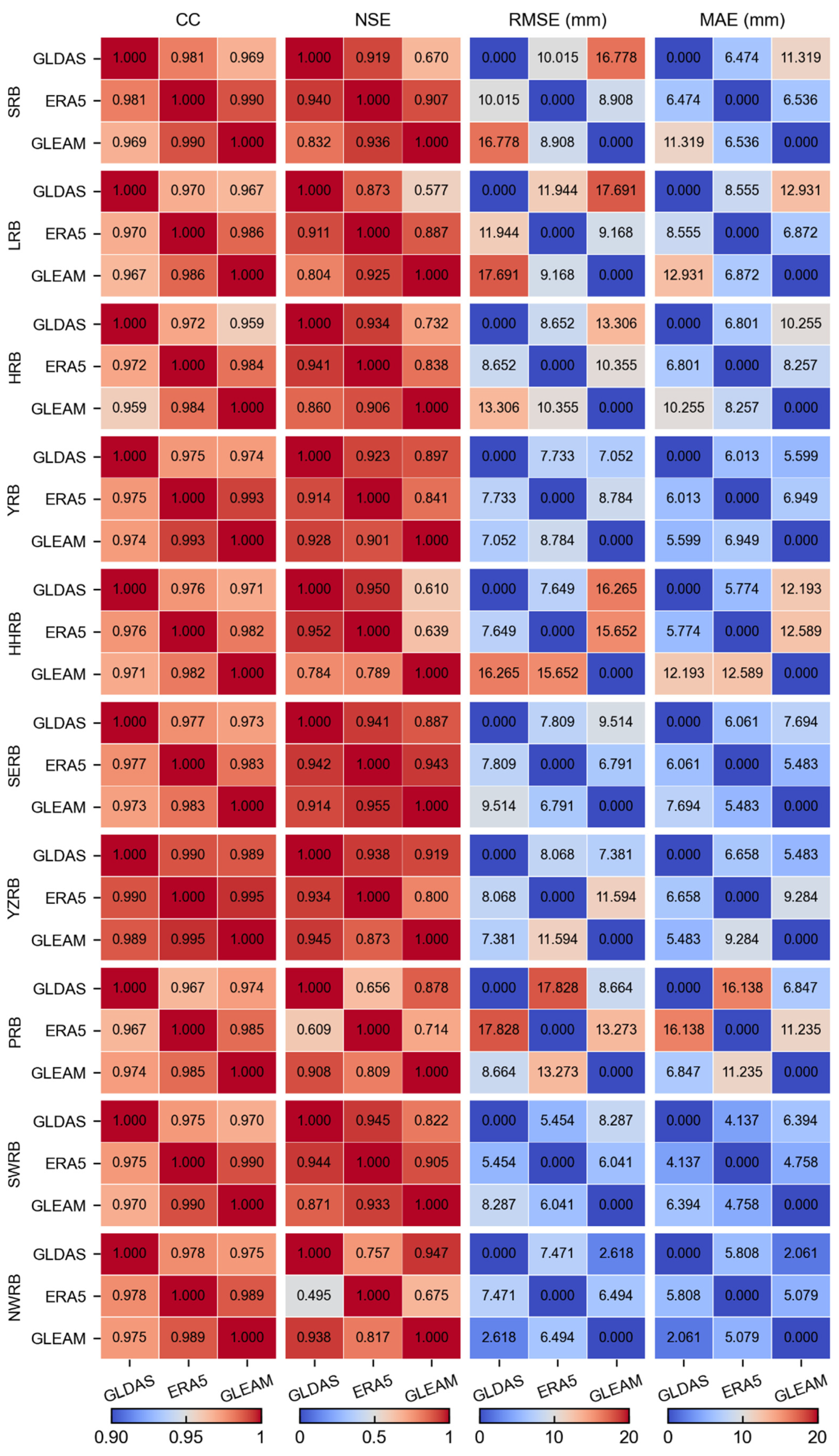

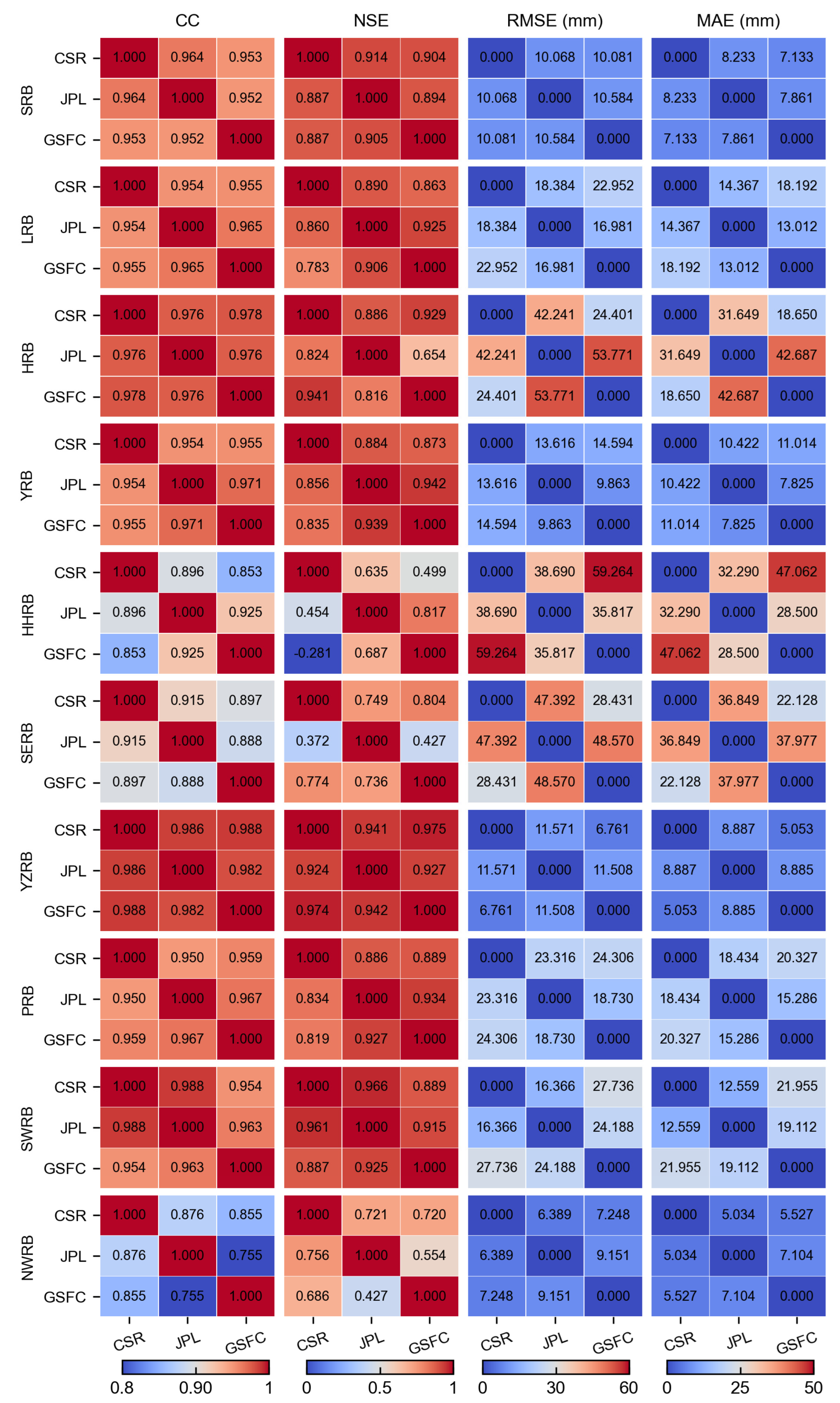
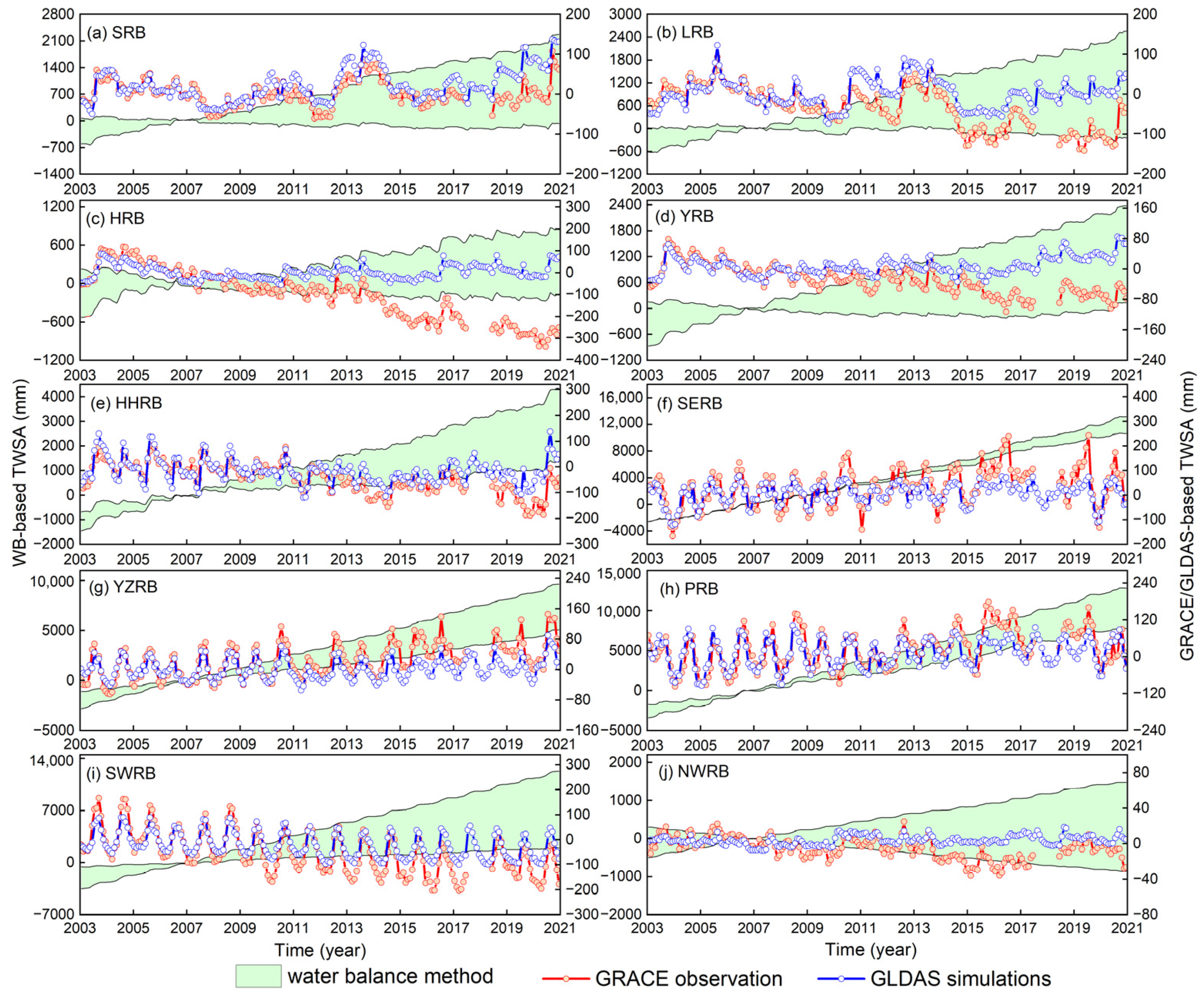
| Dataset | Platform | Spatial Resolution | Time Span | Website |
|---|---|---|---|---|
| TWSA | CSR | 0.25° × 0.25° | 2003–2021 | http://www2.csr.utexas.edu/ (accessed on 3 February 2022) |
| JPL | 0.50° × 0.50° | 2003–2021 | https://podaac-opendap.jpl.nasa.gov/ (accessed on 3 February 2022) | |
| GSFC | 0.50° × 0.50° | 2003–2021 | https://earth.gsfc.nasa.gov/geo/data/grace-mascons (accessed on 3 February 2022) | |
| Precipitation | CMA | 0.50° × 0.50° | 1962–2020 | http://data.cma.cn/ (accessed on 1 March 2021) |
| GPM | 0.10° × 0.10° | 2000–2021 | https://gpm.nasa.gov/data/directory (accessed on 1 June 2022) | |
| GLDAS | 0.25° × 0.25° | 2000–2021 | https://disc.gsfc.nasa.gov/ (accessed on 1 May 2022) | |
| ERA5 | 0.25° × 0.25° | 1979–2021 | https://www.ecmwf.int/en/forecasts/datasets/reanalysis-datasets/era5 (accessed on 1 May 2022) | |
| ET | GLEAM | 0.25° × 0.25° | 1980–2020 | https://www.gleam.eu (accessed on 1 June 2022) |
| GLDAS | 0.25° × 0.25° | 2000–2021 | https://disc.gsfc.nasa.gov/ (accessed on 1 May 2022) | |
| ERA5 | 0.25° × 0.25° | 1979–2021 | https://www.ecmwf.int/en/forecasts/datasets/reanalysis-datasets/era5 (accessed on 1 May 2022) | |
| Runoff | GLDAS | 0.25° × 0.25° | 2000–2021 | https://disc.gsfc.nasa.gov/ (accessed on 1 May 2022) |
| Name | Precp | ET | Runoff | Name | Precp | ET | Runoff |
|---|---|---|---|---|---|---|---|
| Case 1 | CMA | ERA5 | GLDAS | Case 7 | GLDAS | ERA5 | GLDAS |
| Case 2 | CMA | GLDAS | GLDAS | Case 8 | GLDAS | GLDAS | GLDAS |
| Case 3 | CMA | GLEAM | GLDAS | Case 9 | GLDAS | GLEAM | GLDAS |
| Case 4 | GPM | ERA5 | GLDAS | Case 10 | ERA5 | ERA5 | GLDAS |
| Case 5 | GPM | GLDAS | GLDAS | Case 11 | ERA5 | GLDAS | GLDAS |
| Case 6 | GPM | GLEAM | GLDAS | Case 12 | ERA5 | GLEAM | GLDAS |
| Cases | SRB | LRB | HRB | YRB | HHRB | SERB | YZRB | PRB | SWRB | NWRB | |
|---|---|---|---|---|---|---|---|---|---|---|---|
| CC | Case 1 | 0.20 | −0.56 | 0.83 | 0.68 | −0.55 | 0.38 | 0.55 | 0.44 | −0.51 | 0.49 |
| Case 2 | 0.40 | 0.90 | 0.55 | −0.68 | −0.53 | 0.38 | 0.54 | 0.43 | −0.50 | −0.41 | |
| Case 3 | 0.03 | −0.65 | −0.65 | −0.68 | −0.64 | 0.38 | 0.54 | 0.43 | −0.52 | −0.47 | |
| Case 4 | 0.06 | −0.65 | −0.03 | 0.70 | −0.61 | 0.38 | 0.55 | 0.43 | −0.53 | 0.49 | |
| Case 5 | 0.15 | −0.40 | −0.80 | −0.66 | −0.60 | 0.38 | 0.54 | 0.43 | −0.53 | 0.68 | |
| Case 6 | 0.00 | −0.68 | −0.84 | −0.66 | −0.65 | 0.38 | 0.54 | 0.43 | −0.53 | 0.43 | |
| Case 7 | 0.03 | −0.69 | −0.66 | −0.02 | −0.63 | 0.38 | 0.55 | 0.44 | −0.53 | 0.47 | |
| Case 8 | 0.06 | −0.65 | −0.87 | −0.71 | −0.62 | 0.38 | 0.54 | 0.43 | −0.52 | −0.46 | |
| Case 9 | −0.01 | −0.70 | −0.87 | −0.70 | −0.66 | 0.38 | 0.54 | 0.43 | −0.53 | −0.50 | |
| Case 10 | 0.01 | −0.64 | −0.79 | −0.73 | −0.57 | 0.38 | 0.54 | 0.43 | −0.54 | −0.44 | |
| Case 11 | 0.03 | −0.42 | −0.83 | −0.75 | −0.55 | 0.38 | 0.54 | 0.43 | −0.54 | −0.46 | |
| Case 12 | −0.02 | −0.67 | −0.86 | −0.74 | −0.64 | 0.38 | 0.54 | 0.43 | −0.54 | −0.47 | |
| Long-term trends (mm/year) | Case 1 | 28.81 | 39.74 | −22.71 | −8.30 | 83.74 | 845.56 | 321.65 | 547.52 | 160.37 | −41.79 |
| Case 2 | −14.92 | −15.67 | −2.30 | 45.12 | 90.25 | 896.83 | 398.47 | 737.70 | 140.72 | 19.56 | |
| Case 3 | 85.81 | 89.33 | 16.30 | 59.11 | 229.43 | 832.75 | 434.01 | 683.51 | 206.57 | 16.49 | |
| Case 4 | 75.94 | 76.11 | 3.28 | −12.09 | 143.92 | 830.89 | 323.71 | 569.31 | 322.23 | −64.17 | |
| Case 5 | 32.20 | 20.69 | 23.69 | 41.34 | 150.43 | 882.16 | 400.52 | 759.49 | 302.58 | −2.82 | |
| Case 6 | 132.93 | 125.69 | 42.30 | 55.33 | 289.61 | 818.08 | 436.07 | 705.29 | 368.43 | −5.90 | |
| Case 7 | 103.03 | 124.18 | 21.88 | 6.48 | 141.72 | 898.78 | 320.86 | 565.44 | 374.33 | −24.59 | |
| Case 8 | 59.30 | 68.76 | 42.29 | 59.90 | 148.23 | 950.05 | 397.67 | 755.62 | 354.68 | 36.76 | |
| Case 9 | 160.02 | 173.76 | 60.89 | 73.89 | 287.41 | 885.97 | 433.22 | 701.43 | 420.53 | 33.68 | |
| Case 10 | 96.25 | 85.24 | 27.86 | 102.59 | 102.18 | 782.40 | 566.12 | 725.83 | 831.21 | 47.22 | |
| Case 11 | 52.52 | 29.83 | 48.27 | 156.01 | 108.68 | 833.67 | 642.93 | 916.01 | 811.56 | 108.57 | |
| Case 12 | 153.25 | 134.83 | 66.87 | 170.00 | 247.87 | 769.59 | 678.48 | 861.82 | 877.40 | 105.50 | |
| GRACE | −0.14 | −7.84 * | −18.91 * | −5.96 * | −7.51 * | 4.80 * | 4.52 * | 4.72 * | −10.26 * | −1.326 * | |
Publisher’s Note: MDPI stays neutral with regard to jurisdictional claims in published maps and institutional affiliations. |
© 2022 by the authors. Licensee MDPI, Basel, Switzerland. This article is an open access article distributed under the terms and conditions of the Creative Commons Attribution (CC BY) license (https://creativecommons.org/licenses/by/4.0/).
Share and Cite
Zhang, M.; Teng, Y.; Jiang, Y.; Yin, W.; Wang, X.; Zhang, D.; Liao, J. Evaluation of Terrestrial Water Storage Changes over China Based on GRACE Solutions and Water Balance Method. Sustainability 2022, 14, 11658. https://doi.org/10.3390/su141811658
Zhang M, Teng Y, Jiang Y, Yin W, Wang X, Zhang D, Liao J. Evaluation of Terrestrial Water Storage Changes over China Based on GRACE Solutions and Water Balance Method. Sustainability. 2022; 14(18):11658. https://doi.org/10.3390/su141811658
Chicago/Turabian StyleZhang, Menglin, Yanguo Teng, Yazhen Jiang, Wenjie Yin, Xuelei Wang, Dasheng Zhang, and Jinfeng Liao. 2022. "Evaluation of Terrestrial Water Storage Changes over China Based on GRACE Solutions and Water Balance Method" Sustainability 14, no. 18: 11658. https://doi.org/10.3390/su141811658






